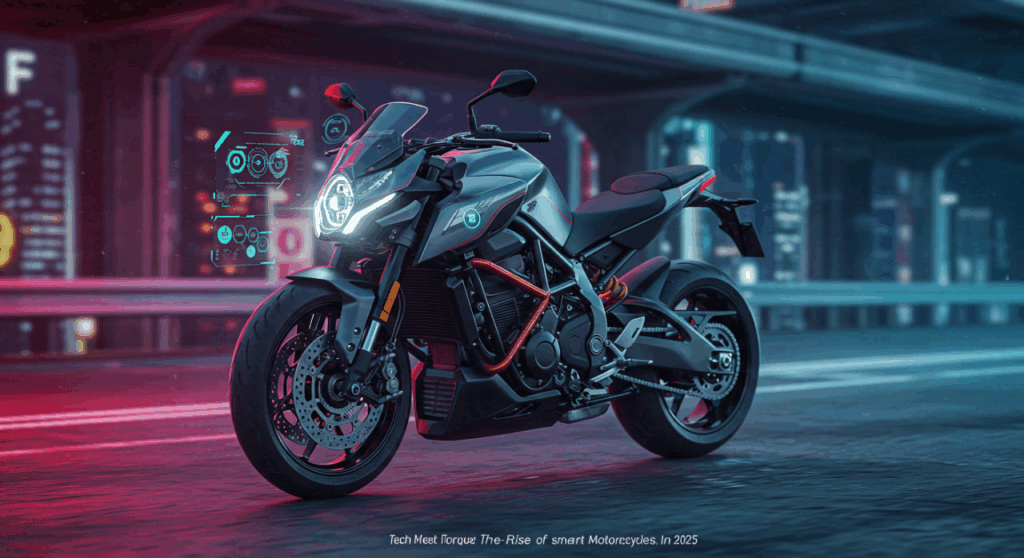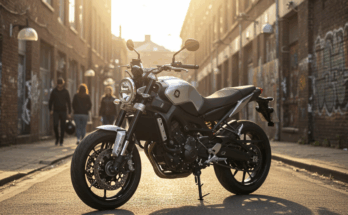The roar of a motorcycle engine has always been synonymous with freedom, adventure, and raw power. But in 2025, the world of motorcycling is undergoing a radical transformation, driven by cutting-edge technology that blends performance with intelligence. Smart motorcycles are no longer a futuristic fantasy—they’re here, redefining how we ride, navigate, and connect with our machines. From AI-assisted riding systems to integrated connectivity, this article dives into the latest innovations in motorcycle technology, reviewing the standout models of 2025 and exploring how they enhance the rider’s experience. Whether you’re a seasoned biker or a curious tech enthusiast, join us as we explore the intersection of torque and tech.
The Evolution of Smart Motorcycles
What Makes a Motorcycle “Smart”?
A smart motorcycle integrates advanced technology to improve safety, performance, and rider convenience. Unlike traditional bikes, these machines leverage artificial intelligence (AI), Internet of Things (IoT) connectivity, and advanced sensors to create a seamless riding experience. Imagine a bike that warns you of a potential collision, adjusts suspension based on road conditions, or syncs with your smartphone to provide real-time navigation and performance stats. In 2025, manufacturers like BMW, Yamaha, and Honda are leading the charge, embedding features that make riding safer, smarter, and more exhilarating.
A Brief History of Motorcycle Tech
Motorcycles have come a long way from their mechanical roots. The introduction of anti-lock braking systems (ABS) in the 1980s was a game-changer for safety. Traction control followed in the 2000s, giving riders better control on slippery surfaces. Today, smart motorcycles take these advancements further with features like adaptive cruise control, heads-up displays (HUDs), and voice-activated controls. These innovations reflect a broader trend in the automotive industry, where connectivity and automation are transforming vehicles into intelligent companions.

Top Smart Motorcycles of 2025: Reviews and Features
BMW R 1300 GS: The Ultimate Adventure Companion
Design and Build
The BMW R 1300 GS is a beast designed for adventure riders who crave versatility. Its sleek, aerodynamic frame houses a 1,300cc boxer engine that delivers 145 horsepower, making it ideal for both urban commutes and off-road escapades. The bike’s lightweight chassis and adjustable handlebars ensure comfort during long rides, while its rugged aesthetic appeals to those who live for the open road.
Smart Features
What sets the R 1300 GS apart is its suite of intelligent features. The Active Cruise Control (ACC) uses radar sensors to maintain a safe distance from vehicles ahead, automatically adjusting speed in traffic. The 6.5-inch TFT display integrates with BMW’s ConnectedRide app, offering navigation, call management, and ride analytics. The bike also boasts an AI-driven Riding Assistant that detects obstacles and alerts riders to potential hazards, such as sharp turns or sudden stops. For night rides, the adaptive LED headlights adjust beam intensity based on ambient conditions, ensuring optimal visibility.
Rider Experience
Riding the R 1300 GS feels like partnering with a high-tech co-pilot. The bike’s Dynamic Suspension Adjustment adapts to terrain in real time, smoothing out bumps on gravel trails while maintaining precision on highways. Testers praise its intuitive interface, though some note the learning curve for mastering the app’s full functionality. Priced at around $22,000, it’s a premium investment, but its blend of power and intelligence makes it a top contender for 2025.
Yamaha MT-10 SP: The Tech-Infused Street Fighter
Design and Build
The Yamaha MT-10 SP is a naked bike that screams aggression with its angular design and minimalist bodywork. Powered by a 998cc inline-four engine, it pumps out 160 horsepower, offering thrilling acceleration for urban riders and track enthusiasts alike. Its compact frame and adjustable ergonomics make it accessible for riders of varying sizes.
Smart Features
The MT-10 SP shines with its Öhlins Smart EC 2.0 suspension, which uses sensors to adjust damping based on speed and road conditions. The bike’s 4.2-inch color display integrates with Yamaha’s Y-Connect app, allowing riders to monitor fuel efficiency, maintenance schedules, and even incoming texts. The Quick Shift System (QSS) enables clutchless gear changes, while the six-axis Inertial Measurement Unit (IMU) optimizes traction and slide control for dynamic cornering.
Rider Experience
The MT-10 SP delivers a visceral riding experience with a tech edge. Its responsive handling and customizable ride modes (Sport, Street, and Rain) cater to diverse conditions, making it versatile for city streets and winding backroads. However, its aggressive throttle response may overwhelm novice riders. Priced at approximately $16,500, it’s a compelling option for those seeking a balance of raw power and smart tech.
Honda CBR1000RR-R Fireblade SP: Track-Ready Innovation
Design and Build
The Honda CBR1000RR-R Fireblade SP is a superbike built for speed. Its 1,000cc inline-four engine produces a staggering 214 horsepower, making it a favorite among track riders. The aerodynamic fairings and lightweight titanium components enhance performance, while the aggressive riding position prioritizes control at high speeds.
Smart Features
Honda equips the Fireblade SP with a Smart Key system for keyless ignition and a 5-inch TFT dashboard that syncs with smartphones for navigation and telemetry data. The bike’s Electronic Steering Damper (HESD) adjusts based on speed, ensuring stability during high-speed runs. The Honda Selectable Torque Control (HSTC) offers nine levels of traction control, allowing riders to fine-tune performance. Additionally, the AI-assisted Cornering ABS optimizes braking during leans, reducing the risk of skids.
Rider Experience
The Fireblade SP is a precision instrument, delivering unmatched speed and control on the track. Its tech features enhance confidence, particularly the cornering ABS, which feels like a safety net during aggressive maneuvers. However, its stiff suspension and race-focused ergonomics may feel unforgiving on long rides. At $28,000, it’s a niche choice for performance-driven riders.
The Impact of Smart Technology on Rider Safety
Collision Avoidance and AI Assistance
Smart motorcycles are revolutionizing rider safety. AI-driven systems, like those in the BMW R 1300 GS, use radar and cameras to monitor surroundings, warning riders of obstacles or erratic drivers. These systems can reduce reaction times, potentially preventing accidents. For example, Yamaha’s IMU technology adjusts traction in real time, helping riders maintain control on wet or uneven surfaces.
Connectivity and Emergency Response
Connectivity features, such as those in the Yamaha MT-10 SP, allow bikes to send crash alerts to emergency contacts via smartphone apps. Some models, like the BMW, integrate with eCall systems, which automatically notify emergency services with the rider’s location in case of a crash. These advancements are particularly valuable for solo riders tackling remote routes.
Limitations and Challenges
Despite their benefits, smart motorcycles face challenges. High costs can deter budget-conscious riders, and complex systems may require regular software updates or maintenance. Additionally, overreliance on tech could reduce rider skill development, particularly for beginners. Manufacturers must balance innovation with accessibility to ensure broad adoption.
Why Smart Motorcycles Matter in 2025
The rise of smart motorcycles reflects a broader shift toward connected, intelligent vehicles. These bikes offer more than just performance—they provide a safer, more engaging riding experience. For tech enthusiasts, the integration of AI and IoT opens new possibilities, from personalized ride settings to real-time diagnostics. For traditional riders, smart features enhance safety without sacrificing the thrill of the ride. As manufacturers continue to innovate, 2025 marks a pivotal moment where technology and torque converge, redefining motorcycling for a new generation.
FAQ
What is a smart motorcycle?
A smart motorcycle incorporates advanced technologies like AI, IoT connectivity, and sensors to enhance safety, performance, and rider convenience. Features may include adaptive cruise control, collision warnings, and smartphone integration.
Are smart motorcycles safe for beginners?
While smart motorcycles offer safety features like ABS and traction control, their complexity and power may overwhelm novice riders. Beginners should start with simpler models and gradually transition to smart bikes.
How much do smart motorcycles cost?
Prices vary widely. Entry-level smart bikes, like the Yamaha MT-10 SP, start around $16,000, while premium models like the Honda CBR1000RR-R Fireblade SP can exceed $28,000.
Can smart motorcycle features be customized?
Yes, most smart motorcycles allow riders to customize settings like suspension, traction control, and ride modes via onboard displays or smartphone apps.
Do smart motorcycles require special maintenance?
Smart motorcycles may need regular software updates and sensor calibration, in addition to standard maintenance like oil changes and tire checks. Always consult the manufacturer’s guidelines.



